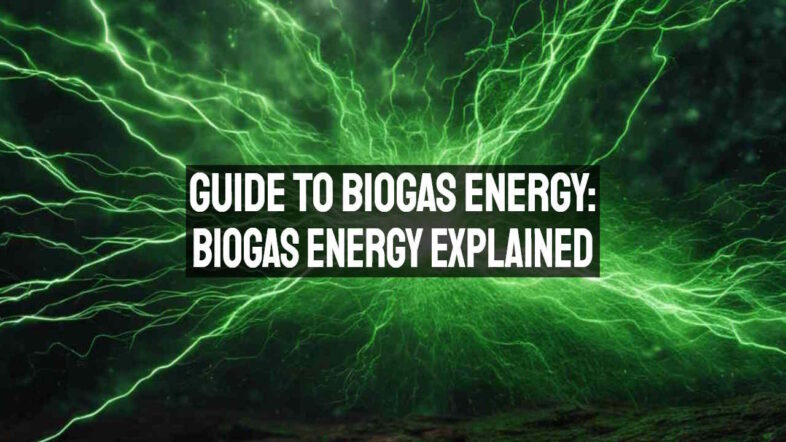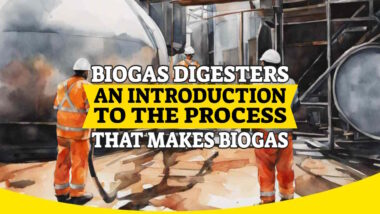Biogas is generated when bacteria degrade biological material in the absence of oxygen, in a process known as anaerobic digestion. Since biogas is a mixture of methane (also known as marsh gas or natural gas, CH4) and carbon dioxide it is a renewable fuel produced from waste treatment.
Anaerobic digestion is basically a simple process carried out in a number of steps that can use almost any organic material as a substrate.

It occurs in digestive systems, marshes, rubbish dumps, septic tanks and the Arctic Tundra. Humans tend to make the process as complicated as possible in many a guide to biogas energy, by trying to improve on nature in complex machines but a simple approach is still possible.
Conventional anaerobic digestion has been a “liquid” process, where waste is mixed with water to facilitate digestion, but a “solid” process is also possible, as occurs in landfill sites.
Biogas can be used directly for cooking/heating, light or even absorption refrigeration for simple applications the complication and energy waste of trying to make electricity from biogas is not necessary. You can also run pumps and equipment off a gas-powered engine rather than using electricity.
There are many advantages of biogas over wood as a cooking fuel:-
– Less labour than tree felling
– Trees can be retained
– Biogas is a quick, easily controlled fuel
– No smoke or smell (unless there is a leak – then you need to know anyway!) so reduced eye/respiratory irritation
– Clean pots
– Sludge is a better fertiliser than manure or synthetic fertilisers (and is cheaper than manufactured products)
– Reduced pathogen transmission compared to untreated waste
Biogas energy is thought to be among the most effective renewable energy sources. Biogas systems can be really stated to produce pure green electrical energy. For the operation of these properties, domestic energy sources such as bio-waste and compost greens produce biogas successfully.

In recent years, the importance of biogas energy has actually risen manifold and has actually ended up being universal. This is because of the realization that biogas capture and utilization is a fantastic opportunity in managing worldwide warming.
By recording biogas any place it is formed, we not only tap a source of clean energy, but we also prevent the escape of methane to the environment. Considering that methane has about 25 times greater global warming capacity than CO2, methane capture with biogas energy in this way can contribute considerably to reducing worldwide warming control.
Biogas is produced by means of a process called Anaerobic Digestion (AD), which results in the production of numerous gases that can then be burnt to produce energy. Anaerobic digestion is the breakdown of different plant and animal products (known as biomass) by bacteria in an oxygen-free environment.
For example, the waste plant material is sealed in an airtight container, and then bacteria is included, which is motivated to increase and grow, releasing methane and other gases as the spin-off of the process.
In addition, there are other by-products produced at the same time which are rich in nutrients and can be used as fertiliser. The inputs in the process can be any variety of biomass products including any of the following: food waste, energy crops, crop residues, slurry and manure. In practice the process can handle waste from families, grocery stores and markets, therefore decreasing the waste that goes to landfills.
Increasing energy prices, more comprehensive regulatory demands, and enhanced competitors in the marketplace are causing lots in American farming's livestock sector to consider anaerobic digestion of animal waste for power production by means of biogas. The readers of this guide to biogas energy will note that his biological fuel-creating technology is a method to cut costs, address environmental concerns and create renewable energy.
Anaerobic digesters are animal waste tanks or storage ponds sealed with covers that trap the biogas produced in a digester, producing a type of “biogas plant”. The biogas is then pulled from the digester by providing a small vacuum on a pipeline with a gas pump or blower. Biogas, which includes 60 %– 80 % methane, is made used to produce energy. Methane can power an engine generator to produce electrical power for your property or to be put back on the grid. The methane gas can also be utilized to operate a boiler or space heater, as well as chilling and refrigeration equipment. Gas that is not made use of for energy manufacturing is ignited and flared to reduce methane discharges and odour.
In the establishing nations biogas energy is produced when cow dung is combined with water and placed into fermentation pits where it is broken down by natural bacteria, launching methane. The gas is collected and saved in a tank and then piped on the need to the farmer's residence, to be burnt to generate energy for cooking, laundry and lighting.
The kind of energy made use of is a major consideration in determining an item's effect on the environment. While recycled content is excellent, it is not adequate to lower a paper's ecological footprint as much as possible. The quantity of water utilized along with the waste and greenhouse gas discharges generated during manufacturing are other elements to take into account. As shown by the Life Cycle Assessment, the energy utilized is largely responsible for the small footprint of biogas energy.
Biogas energy results from the decomposition of waste buried in a landfill site, which has actually been caught to avoid its release into the air and burnt to produce electrical power. If there is no electrical power line close by to the land fill, updated garbage dump gas can be transported by pipeline over a distance of 10 to 15 kilometres economically and into the regional natural gas supply grid.
Perhaps the simplest way to utilize biogas is for heating. This is because, for this function, no pre-treatment other than the removal of water is required. Biogas is generally utilized for heating buildings in combination with a biogas plant, however surplus heat can also be directed into the district heating network.
Biogas energy can also be used to produce power. Both electrical power and heat can be produced with the aid of a gas powered generator. The proportions of heat and power generated depend of course on the design of the plant but are usually in the area of 35 per cent electrical energy and 65 per cent heat.
Biogas energy usually describes a blend of gases produced by the breakdown of any organic matter. It is produced from readily available raw materials such as animal waste, human, and recycled waste. It is a renewable energy source without any carbon footprint.
With fuel wood becoming progressively costly as well as limited in some areas, there is a need to try to find alternative food preparation fuel. Cow manure and biogas fuel innovation provide a free, sustainable source of power all year round – and a helpful fertiliser which helps to supply much better earnings for farmers.
A rural electrification program aims at equitable local distribution of electricity and increasing rural electrical energy access in Uganda. The target of the current Rural Electrification Strategic Plan 2013-2022 is to attain electrification access of 22 % (i.e. customers who will be making use of electrical energy in their homes, companies or institutions) by 2022 from the existing level of 5 % for rural areas.
The popularization of biogas has produced beneficial results from the production of energy, fertilizers and the improvement of health, more productive farming and also environmental improvement.
In India, we have more than one million biogas plants in rural areas, and every year they include thirty to forty thousand plants. There is a need for a large number of biogas energy specialists capable of the setup and upkeep of these plants in rural areas.
The world needs to use the natural wastes produced day-to-day by extracting the offered bio-energy. The generation of sustainable gas will significantly decrease our greenhouse gas emissions. Lower fossil fuel reliance will help to decrease global warming and developing renewable natural gas will tend to avoid deforestation.
Methane destruction is important for the reduction of carbon contamination that is deteriorating our environment.
Also see the Beginners Guide to Biogas at the Wayback Machine.



